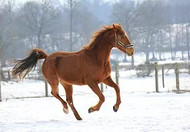Winter Care for Horses Part 2
Dec 7th 2011
WATER
Watering horses in winter is a little more difficult than in summer. A stock tank heater keeps the water above freezing. I have the Nelson automatic heated waterer. The ScratchnAll is just next to it. Having boarded my horses previously, I knew that I didn’t want to be breaking ice in the bucket as extremely cold water can cause colic.
Some people believe horses can get by on snow. “Get by” they might, but so could we. Horses require a lot of water to digest dry feed. How much snow would they have to eat to provide the 5 to 10 gallons of water they need? If you’re not convinced, ask your vet about the greater risk for impaction colic.
Winter Riding
Riding outside in winter presents some additional challenges. Dressing warmly can take care of the weather, but there’s not much you can do about the footing. Stay off icy patches, and remember that frozen ground, even if it’s not icy, can be as hard as concrete. Don’t go any faster than a walk unless there’s a good cushion of snow on top and you know for sure there’s no ice underneath.
Just as we need proper footwear to walk safely on winter ground, so our horses need special provisions. If your horse is shod, talk to your farrier about pads and caulks. If he’s barefoot, spraying the sole with a nonstick cooking product, or even coating it with old fashioned vaseline, can help prevent the snow from balling up. In any case, don’t expect your horse to walk on high heels. Carry a hoofpick with you and be prepared to stop periodically and pick out the icy build up.
Be careful bringing your horse into the barn after being outside. Snow ball feet are very slippery. Preferably, dig out the snow at the barn door. If you can get the hoofpick under the snow pack at the back of the foot, you can often pry it all out at once, especially if you coated the sole as suggested above. Be careful you don’t dig into the frog, though. If you can’t budge it, chip off the snow until it’s even with the hoof wall and then wait for the hooves to warm up before removing the rest.

